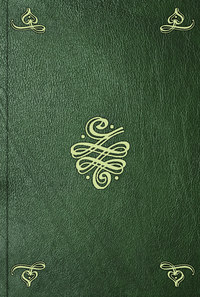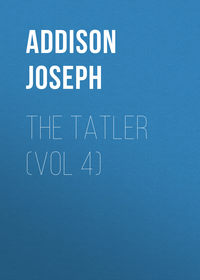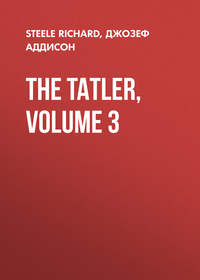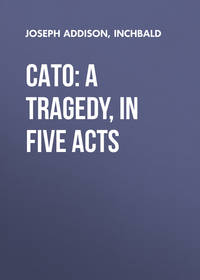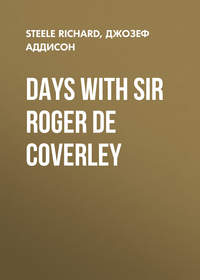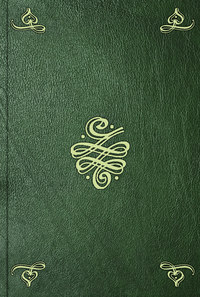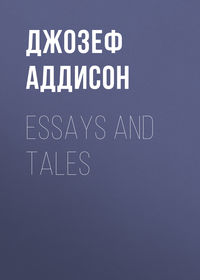 полная версия
полная версияThe Tatler, Volume 1
262
No. 21.
263
It would seem from the passage in the Examiner (vol. iii. No. 48), that three men of distinction at that time, probably noblemen, were supposed to be denoted under the names of Hogshead, Culverin, and Musket, from Wapping; or, as they are named by the Examiner, "Tun, Gun, and Pistol, from Wapping." They are there mentioned among others, said to have been, "with at least fifty more, sufferers of figure under this author's satire, in the days of his mirth," &c. In the Guardian (No. 53) Steele says, "Tun, Gun, and Pistol from Wapping, laughed at the representation which was made of them, and were observed to be more regular in their conduct afterwards."
264
The kept mistress of a knight of the shire near Brentford, who squandered his estate on women, and in contested elections. He has long since gone into the land of oblivion. See No. 51.—(Nichols.)
265
Several such verses, inscribed on the glasses of the Kit Cat Club, are given in Nichols' "Select Collection of Poems," v. 168-178.
266
Admiral Sir John Norris (died 1749) was sent in June 1709, with a small squadron, to stop the French supply of corn from the Baltic.
267
For Steele's other papers on duelling, see Nos. 26, 28, 29, 31, 38, 39.
268
Something imposed upon us.
269
"While this barbarous custom of duelling is tolerated, we shall never be rid of coxcombs, who will defend their understandings by the sword, and force us to bear nonsense on pain of death."—(Steele, Theatre, No. 26.)
270
Swift's "Tale of a Tub," sect. 4.
271
I.e., hold him in.
272
Said to be Bateman and Heathcote, both eminent citizens—(Gentleman's Magazine, lx. 679.)
273
"Mr. Bickerstaff has received a letter, dated June 6, with the just exceptions against the pretence of persons therein mentioned, to the name of Pretty Fellows, which shall be taken notice of accordingly: as likewise, the letter from Anthony Longtail of Canterbury, concerning the death of Thomas à Becket" (folio). See Nos. 24, 26.
274
See Nos. 1, 10, 16.
275
This letter is probably by Anthony Henley; see advertisement at end of No. 25. At this time Henley was M.P. for Weymouth, and a friend of the wits belonging to the Whig party. He died in 1711. See Nos. 11, 193.
276
No. 21.
277
Wall and the others named were quack doctors.
278
Sintelaer, who lived in High Holborn, published in Feb. 1709, "The Scourge of Venus and Mercury. With an appendix in answer to Mr. John Marten's reflections thereupon" (Postman, Feb. 24 to 26, 1709).
279
"Æneid," i. 460. Steele alters Virgil's "terriss" to "villa."
280
A sort of periwig, with a short tie and small round head. See No. 30, end. In the Spectator (No. 319), Dorinda describes a humble servant of hers who "appeared to me in one of those wigs that I think you call a 'night-cap,' which had altered him more effectually than before. He afterwards played a couple of black riding wigs upon me, with the same success."
281
The elaborate canes used by the beaux commonly had a ribbon to enable them to be hung on the button of the waistcoat. Thus we find among the advertisements for lost canes, "A cane with a silver head and a black ribbon in it, the top of it amber, part of the head to turn round, and in it a perspective glass."
282
Men of fashion wore very high-heeled shoes, and their red heels are often satirised by Steele and Addison (cf. Spectator, No. 311). In No. 16 of the Spectator Addison said, "It is not my intention to sink the dignity of this my paper with reflections upon red-heels or topknots."
283
See Nos. 19, 23.
284
Probably Sir John Vanbrugh.
285
A bazaar on the south side of the Strand, between George Court and Durham Street, and opposite Bedford Street. There were two long and double galleries, one above the other, containing shops, with pretty attendants. The New Exchange was a favourite lounge, and is frequently mentioned in the Restoration literature; it was pulled down in 1737. See Spectator, Nos. 96, 155, and Steele's "Lying Lover," act ii. sc. 2, where Young Bookwit says, "My choice was so distracted among the pretty merchants and their dealers, that I knew not where to run first." On the other hand, we find complaints that young fops hindered business by lolling on the counter an hour longer than was necessary, and annoyed the young women who served them with ingenious ribaldry.
286
Vauxhall, or Fox-hall, Gardens were formed about 1661, on the Surrey side of the Thames, and were at first called the New Spring Gardens, to distinguish them from the Old Spring Gardens at Charing Cross. At the end of the seventeenth century Vauxhall was a favourite place for assignations, and Pepys was scandalised at scenes he there witnessed. The gardens were reopened in 1732, after being closed, it would seem, for some years, and they continued to be a place of fashionable resort until the end of the reign of George III.
287
See No. 15.
288
"Whereas several gentlemen have desired this paper with a blank leaf to write business on, and for the convenience of the post; this is to give notice, that this day, and for the future, it may be had of Mr. Morphew, near Stationers' Hall" (folio, advertisement).
289
No. 21.
290
People of fashion dined at about four o'clock in Queen Anne's time, and by six the men, who had often drunk a good deal of wine, would be finding their way to the clubs and coffee-houses.
291
Charles Mather, a toyman in Fleet Street, next door to Nandoe's Coffee-house, over against Chancery Lane. Swift wrote ("Sid Hamet's Rod," 1710):
"No hobby horse with gorgeous top,The dearest in Charles Mather's shop;Or glittering tinsel of MayfairCould with the rod of Sid compare."See Nos. 113, 142, and Spectator, Nos. 328, 503 ("One of Charles Mather's fine tablets"), and 570 ("The famous Charles Mather was bred up under him").
292
Charles Lillie, the perfumer, tells us how snuff came into use. A great quantity of musty snuff was captured in the Spanish fleet taken at Vigo in 1702, and snuff with this special musty flavour became the fashion. In No. 138 of the Spectator, Steele humorously announced that "the exercise of the snuff-box, according to the most fashionable airs and motions, in opposition to the exercise of the fair, will be taught with the best plain or perfumed snuff at Charles Lillie's, perfumer, at the corner of Beaufort Buildings in the Strand."
293
See No. 26.
294
Venice, where mercenaries were employed for fighting purposes.
295
The City train-bands were often the subject of ridicule by the wits. See "Harleian Misc." i. 206, Cowper's "John Gilpin," and Nos. 38, 41. Tothill Fields, Westminster, and the Artillery Ground, Finsbury, were the usual exercising-grounds for the train-bands.
296
The Compter was a prison for the city of London, where debtors and others were confined.
297
Steele wrote at length in the Spectator (No. 436) of a trial of skill in the noble art of self-defence at Hockley-in-the-Hole; and in No. 630 there is an allusion to the gladiators of Hockley-in-the-Hole. In the "Beggar's Opera," Mrs. Peachum says: "You should to Hockley-in-the-Hole and to Marybone, child, to learn valour; there are the schools that have bred so many brave men." As to the other sports at the Bear Garden, see No. 134, and Gay's "Trivia," ii. 407-12:
"When thro' the town, with slow and solemn air,Led by the nostril, walks the muzzled bear;Behind him moves, majestically dull,The pride of Hockley-hole, the surly bull;Learn hence the periods of the week to name:Mondays and Thursdays are the days of game."There were seats, at half a crown and upwards, for the quality; the neighbourhood of the Bear Garden was infested by thieves. The following are specimens of the advertisements common about 1709: "At the Bear-garden, in Hockley in the Hole. A trial of skill, to be performed between two profound masters of the noble science of defence, on Wednesday next, the 13th of July, 1702, at two o'clock precisely. I George Gray, born in the city of Norwich, who has fought in most parts of the West Indies, viz., Jamaica, Barbadoes, and several other parts of the world, in all twenty-five times upon the stage, and was never yet worsted; and am now lately come to London, do invite James Harris to meet, and exercise at the following weapons, back-sword, sword and dagger, sword and buckler, single falchon, and case of falchons. I James Harris, master of the said noble science of defence, who formerly rid in the Horse-guards, and hath fought 110 prizes, and never left a stage to any man, will not fail (God willing) to meet this brave and bold inviter, at the time and place appointed, desiring sharp swords, and from him no favour. No person to be upon the stage, but the seconds. Vivat Regina."
"At the Bear-garden in Hockley in the Hole, near Clerkenwell Green, 1710. This is to give notice to all gentlemen, gamesters, and others, that on this present Monday is a match to be fought by two dogs, one from Newgate-market, against one from Honey-lane market, at a bull, for a guinea to be spent, five let-goes out of hand, which goes fairest and fastest in, wins all. Likewise, a green bull to be baited, which was never baited before; and a bull to be turned loose with fireworks all over him. Also a mad ass to be baited. With a variety of bull-baiting and bear-baiting, and a dog to be drawn up with fireworks. To begin exactly at three of the clock."
298
See Nos. 25, 26, 28.
299
The full-bottomed dress wigs. Another name was "Duvillier," used below.
300
See Percy's "Reliques of Ancient English Poetry," ed. Wheatley, iii. 279. "The Dragon of Wantley" is a satire on the old ballads of chivalry.
301
See Nos. 3, 63.
302
In the list of characters, Wycherley defines Novel as "a pert railing coxcomb, and an admirer of novelties," and Major Oldfox as "an old impertinent fop, given to scribbling."
303
James Cavallier was the celebrated leader of the French Protestants in the Cevennes, when these warlike but enthusiastic mountaineers opposed the tyranny of Lewis XIV. and made a vigorous stand against the whole power of France, which for a long time laboured in vain to subdue them. It was in the heat of this gallant struggle to preserve themselves from religious slavery, that the first seeds of that wild fanaticism were sown, which afterwards grew up to such an amazing extravagance, and distinguished them, by the name of French Prophets, among the most extraordinary enthusiasts that are to be found in the history of human folly. Cavallier, who found in his latter days an hospitable asylum in Ireland, published, in 1726, "Memoirs of the Wars of the Cevennes, under Col. Cavallier, in defence of the Protestants persecuted in that country, and of the peace concluded between him and the Mareschal Duke of Villars; of his conference with the King of France, after the conclusion of the peace; with letters relating thereto, from Mareschal Villars, and Chamillard, secretary of state." (Percy.)
304
It was a younger brother, an abbé, who used his pen and sword against Lewis XIV. He was employed in England, had preferment in the army, and a pension; but, being found a useless villain, he was soon discarded. He then endeavoured to make his peace with France, by acting here as a spy; but being detected, he was brought before the Cabinet Council, to be examined, March 8, 1711. In the course of his examination he took an opportunity to stab Mr. Harley. Of the wounds given to this assassin on that occasion, he died in Newgate soon after. See the "Narrative of Guiscard's Examination," by Mrs. Manley, from facts communicated to her by Dr. Swift. See also Examiner, No. 32. (Nichols.)
305
Soon after the conclusion of the late treaty of peace, the French king dispersed a letter through his dominions, wherein he shows the reasons why he could not ratify the preliminaries. Vide the public newspapers of this date. (Steele.)
306
N.B.—Mons. Bernard and the chief bankers of France became bankrupts about this time (Steele).—See news paragraph in Nos. 3, 5, 9.
307
At the Tower of London. The Tower menagerie was one of the sights of London until its removal in 1834. See Addison's Freeholder; No. 47.
308
In Westminster Abbey.
309
The Priory of Bethlem, in St. Botolph Without, Bishopsgate, was given by Henry VIII. to the Corporation of London, and was from thenceforth used as a hospital for lunatics. In 1675 a new hospital was built near London Wall, in Moorfields, at a cost of £17,000. See Hogarth's "Rake's Progress," Plate 8. In No. 127, Steele calls Bedlam "that magnificent palace."
310
Drury Lane Theatre was closed on June 6, 1709, by order of the Lord Chamberlain, in consequence of Rich's ill-treatment of the actors.
311
See Nos. 25, 26, 28, 29.
312
Probably meant for Llanbadern Vawr, if not a name coined for the occasion.
313
Sir Anthony Fitzherbert's book was published in 1514.
314
See Nos. 28, 134.
315
See Selden, "De Duello" (1610), p. 19.
316
A prize-fighter mentioned in Lansdowne's epilogue to "The Jew of Venice."
317
"Æneid," v. 437 seq.
318
Suetonius, "Life of Nero," chap. 12.
319
An allusion to the rubrics in Roman missals.
320
The fields at the back of Montague House, Bloomsbury, were a favourite place for duels in the first half of the eighteenth century. Cf. Spectator, No. 91: "I shall be glad to meet you immediately in Hyde Park or behind Montague House, or attend you to Barn Elms, or any other fashionable place that's fit for a gentleman to die in."
321
It has been suggested, with some probability, that this letter is by Swift.
322
See No. 4.
323
Borago was a plant formerly used as a cordial.
324
See No. 21.
325
Young Man's Coffee-house at Charing Cross, had a back door into Spring Garden. It seems to have been specially frequented by officers.
326
"Mr. Bickerstaff has received the advices from Clay Hill, which, with all intelligence from honest Mr. Sturdy and others, shall have their place in our future story" (folio).
327
John Norris (1657-1711), the divine, published, in 1688, "The Theory and Regulation of Love, a Moral Essay; to which are added Letters Philosophical and Moral between the author and Doctor Henry More."
328
Henry More, the platonist (1614-87), published "Divine Dialogues," "Conjectura Cabalistica," and many other works.
329
It is not clear why Milton is bracketed with Norris and More; perhaps Swift had in mind such passages about heavenly love as that in "Paradise Lost," viii. 588-614.
330
Swift seems to have been the author of this first portion of No. 32, which contains a scandalous attack on Mary Astell. Nichols thought that Addison also had a share in it. See Nos. 59, 63. Mrs. Astell, a friend of Lady Elizabeth Hastings and John Norris, published, in 1694, her "Serious Proposal to the Ladies," advocating a Church of England monastery, without any irrevocable vows. Provision was made for mental as well as moral training; in fact, the institution was to have been "rather academical than monastic." But Bishop Burnet advised Lady Elizabeth Hastings not to subscribe to the proposed building, and the scheme fell through. In 1709, Miss Astell published a book called "Bart'lemy Fair; or, An Enquiry after Wit.... By Mr. Wotton, in answer to Lord Shaftesbury's Letter concerning Enthusiasm, and other profane writers." In the advertisement to the Second Edition ("An Enquiry after Wit," &c., 1722), Mary Astell says that, although her book was at first published under a borrowed name, it was ascribed to her, and drew upon her the resentment of that sort of men of wit who were exposed, and was the true cause of the fable published in the Tatler a little after the "Enquiry" appeared. But she notes that, although the Tatler showed its teeth against the "Proposal to the Ladies," the compilator made amends to the author (if not to the bookseller), by transcribing above a hundred pages into his Ladies' Library verbatim, except in a few places, which would not be found to be improved. The "Enquiry after Wit" is dedicated "To the most Illustrious Society of the Kit-Cats," with many sarcastic allusions to their luxury, oaths, &c. True, their names had not been heard of from Hochsted or Ramillies, but then their heroism found in every place an ample theatre for their merits. "The Bath, the Wells, and every Fair, each Chocolate, Gaming House and Tavern resounds with your noble exploits."
331
This is borrowed from Sir Thomas Browne's "Religio Medici," part ii. sect. 9.
332
"Second," in original editions.
333
There is an apology for punning in No. 36 of the Guardian.
334
Swift.
335
See No. 31.
336
See Sallust, "Bell. Catal." chap. 21. The person here referred to as Sempronia is said to be the same as the Madam d'Epingle elsewhere alluded to.
337
See p. 273, note.
338
A small violin or fiddle. See No. 160.
339
A dancing-master, who either was French, or pretended to be so. See No. 109.
340
A song of Waller's begins:
"Behold the brand of beauty tost!See, how the motion doth dilate the flame!"(Dobson).341
The rigadoon was a dance for two persons. Cf. Guardian, No. 154: "We danced a rigadoon together."
342
On the site of Eaton and Belgrave Squares. See Spectator, No. 137: "The Five Fields towards Chelsea."
343
In "Bartholomew Fair," act ii. sc. i. Overdo went to the Fair in disguise, and being mistaken for a cutpurse, was well beaten.
344
Salter, a barber, opened a coffee-house in Cheyne Walk, Chelsea, in 1695. Sir Harry Sloane, whose servant he had been, gave him some curiosities to start a museum. Others, including Admiral Munden and his fellow-officers, added to the collection, and the first catalogue appeared in 1729. The more startling curiosities were, of course, not genuine. The remains of the collection were sold in 1799 for about £50. A view of Salter's house will be found in Timbs' "Clubs and Club Life in London." Verses of a more or less coarse nature by Don Saltero appeared not unfrequently in the "British Apollo," in 1709.
345
From "gingiva," the gum.
346
Salter played very badly on the fiddle.
347
"Sir Roger de Coverley," the famous country-dance tune.
348
By Dr. Henry Aldrich, Dean of Christ Church, Oxford, where Steele matriculated.
349
"De Poematum cantu, et viribus Rythmi," 1673.
350
Master Nicholas. See "Don Quixote," chap. v.
351
There were two John Tradescants (father and son) who collected objects of natural history. Their collection formed the foundation of the Ashmolean Museum at Oxford. The "Museum Tradescantianum: or, A Collection of Rarities preserved at South Lambeth, near London, by John Tradescant," contains interesting portraits of both John Tradescant, senior, and John Tradescant, junior, as well as a plate of the Tradescant arms.
352
A sclopeta or sclopetta was a hand-gun used by Spaniards.
353
Toledo was famous for its sword-blades.
354
Salter had an old grey muff, which he clapped constantly to his nose, and by which he was distinguishable at the distance of a quarter of a mile. His wife was none of the best, being much addicted to scolding.-(Nichols.)
355
See Nos. 79, 140; and Swift's "Journal to Stella," Nov. 3, 1711. A correspondent begged the Spectator (No. 344) to "take notice of an impertinent custom the women, the fine women, have lately fallen into, of taking snuff."
356
It has been suggested that Steele here alludes to Mrs. De la Rivière Manley.
357
Lord Hinchinbroke married Elizabeth, only daughter of Alexander Popham, Esq. See Nos. 1, 5, 22.
358
This was one of Steele's own letters to Miss Scurlock. (See "Correspondence," 1809, vol. i. p. 93.) "Mrs. Lucy" is "Mrs. Warren" in the original.
359
"Hamlet," act iii. sc. 2.
360
See No. 32.
361
This letter is printed in Scott's edition of Swift's works.
362
See No. II.
363
Nichols argued that this and the two following numbers were by Addison. (1) At the end of No. 37 there is a list of errata for the preceding number. It was Addison's frequent practice to make verbal alterations in a preceding paper, and this Steele never did, except in rare cases, or where there was a positive mistake. (2) All the three papers are superscribed, as Addison's often were, and appear upon the face of them, to be of the nature, and in the number of those, for which Steele stood sponsor, and was very patiently traduced and calumniated, as he acknowledges to Congreve, in the Dedication prefixed to "The Drummer." There is nothing in the style or manner of any of the three that appears incongruous with such a supposition; and the nature of their principal contents seems to support it. They consist chiefly of pleasantries and oblique strokes, apparently on persons of fashion, in that age, of both sexes. It appears from the Dedication to "The Drummer," that Steele had Addison's direct injunctions to hide papers which he never did declare to be Addison's. The case, in short, seems to be, that as, as Steele says, there are communications in the course of this work, which Addison's modesty, so there are likewise others, which Addison's prudence, "would never have admitted to come into daylight, but under such a shelter." According to the usual rule where there is uncertainty, Steele's name is placed at the head of the papers in this edition. Probably he was responsible in any case for part of the contents of each of these numbers.




